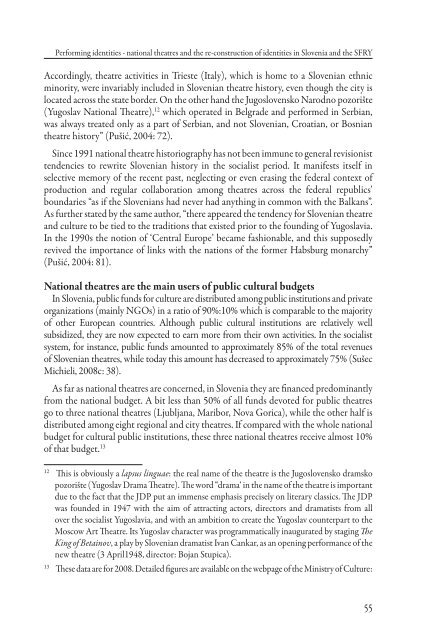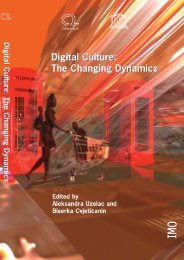free download in pdf format - Culturelink Network
free download in pdf format - Culturelink Network
free download in pdf format - Culturelink Network
Create successful ePaper yourself
Turn your PDF publications into a flip-book with our unique Google optimized e-Paper software.
Perform<strong>in</strong>g identities - national theatres and the re-construction of identities <strong>in</strong> Slovenia and the SFRY<br />
Accord<strong>in</strong>gly, theatre activities <strong>in</strong> Trieste (Italy), which is home to a Slovenian ethnic<br />
m<strong>in</strong>ority, were <strong>in</strong>variably <strong>in</strong>cluded <strong>in</strong> Slovenian theatre history, even though the city is<br />
located across the state border. On the other hand the Jugoslovensko Narodno pozorište<br />
(Yugoslav National Th eatre), 12 which operated <strong>in</strong> Belgrade and performed <strong>in</strong> Serbian,<br />
was always treated only as a part of Serbian, and not Slovenian, Croatian, or Bosnian<br />
theatre history” (Pušić, 2004: 72).<br />
S<strong>in</strong>ce 1991 national theatre historiography has not been immune to general revisionist<br />
tendencies to rewrite Slovenian history <strong>in</strong> the socialist period. It manifests itself <strong>in</strong><br />
selective memory of the recent past, neglect<strong>in</strong>g or even eras<strong>in</strong>g the federal context of<br />
production and regular collaboration among theatres across the federal republics’<br />
boundaries “as if the Slovenians had never had anyth<strong>in</strong>g <strong>in</strong> common with the Balkans”.<br />
As further stated by the same author, “there appeared the tendency for Slovenian theatre<br />
and culture to be tied to the traditions that existed prior to the found<strong>in</strong>g of Yugoslavia.<br />
In the 1990s the notion of ‘Central Europe’ became fashionable, and this supposedly<br />
revived the importance of l<strong>in</strong>ks with the nations of the former Habsburg monarchy”<br />
(Pušić, 2004: 81).<br />
National theatres are the ma<strong>in</strong> users of public cultural budgets<br />
In Slovenia, public funds for culture are distributed among public <strong>in</strong>stitutions and private<br />
organizations (ma<strong>in</strong>ly NGOs) <strong>in</strong> a ratio of 90%:10% which is comparable to the majority<br />
of other European countries. Although public cultural <strong>in</strong>stitutions are relatively well<br />
subsidized, they are now expected to earn more from their own activities. In the socialist<br />
system, for <strong>in</strong>stance, public funds amounted to approximately 85% of the total revenues<br />
of Slovenian theatres, while today this amount has decreased to approximately 75% (Sušec<br />
Michieli, 2008c: 38).<br />
As far as national theatres are concerned, <strong>in</strong> Slovenia they are fi nanced predom<strong>in</strong>antly<br />
from the national budget. A bit less than 50% of all funds devoted for public theatres<br />
go to three national theatres (Ljubljana, Maribor, Nova Gorica), while the other half is<br />
distributed among eight regional and city theatres. If compared with the whole national<br />
budget for cultural public <strong>in</strong>stitutions, these three national theatres receive almost 10%<br />
of that budget. 13<br />
12 Th is is obviously a lapsus l<strong>in</strong>guae: the real name of the theatre is the Jugoslovensko dramsko<br />
pozorište (Yugoslav Drama Th eatre). Th e word “drama‘ <strong>in</strong> the name of the theatre is important<br />
due to the fact that the JDP put an immense emphasis precisely on literary classics. Th e JDP<br />
was founded <strong>in</strong> 1947 with the aim of attract<strong>in</strong>g actors, directors and dramatists from all<br />
over the socialist Yugoslavia, and with an ambition to create the Yugoslav counterpart to the<br />
Moscow Art Th eatre. Its Yugoslav character was programmatically <strong>in</strong>augurated by stag<strong>in</strong>g Th e<br />
K<strong>in</strong>g of Beta<strong>in</strong>ov, a play by Slovenian dramatist Ivan Cankar, as an open<strong>in</strong>g performance of the<br />
new theatre (3 April1948, director: Bojan Stupica).<br />
13 Th ese data are for 2008. Detailed fi gures are available on the webpage of the M<strong>in</strong>istry of Culture:<br />
55



